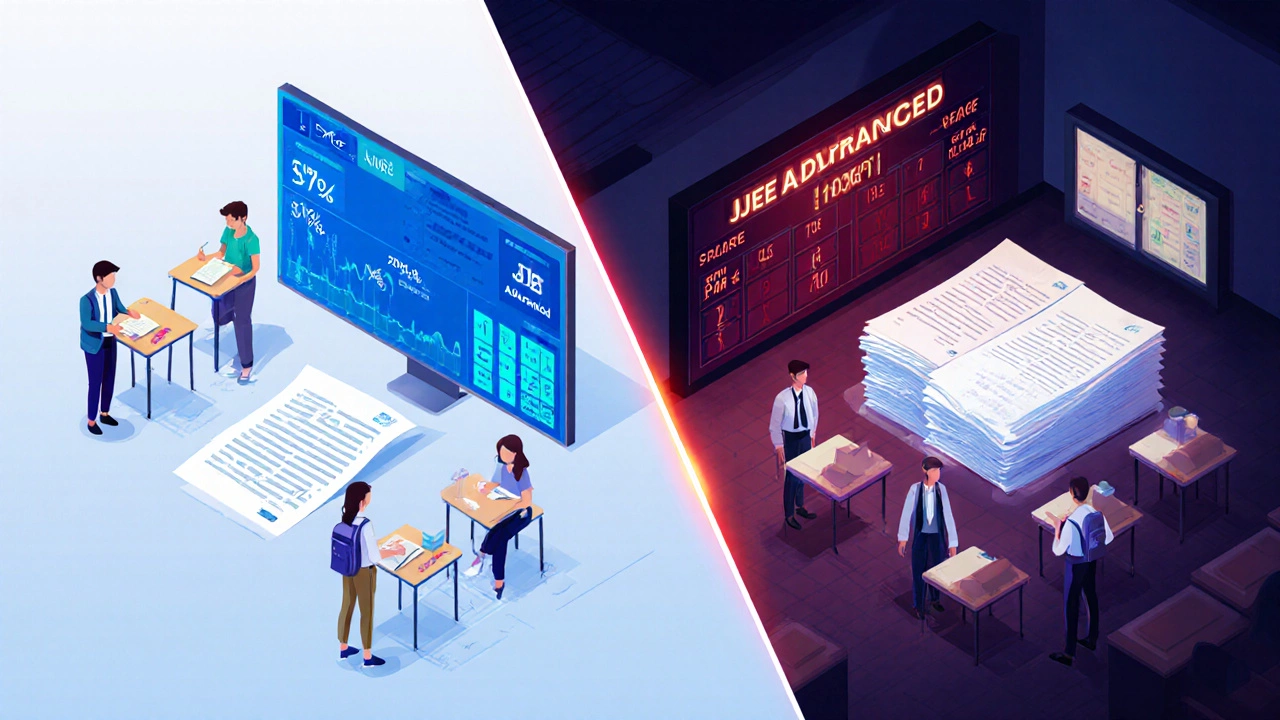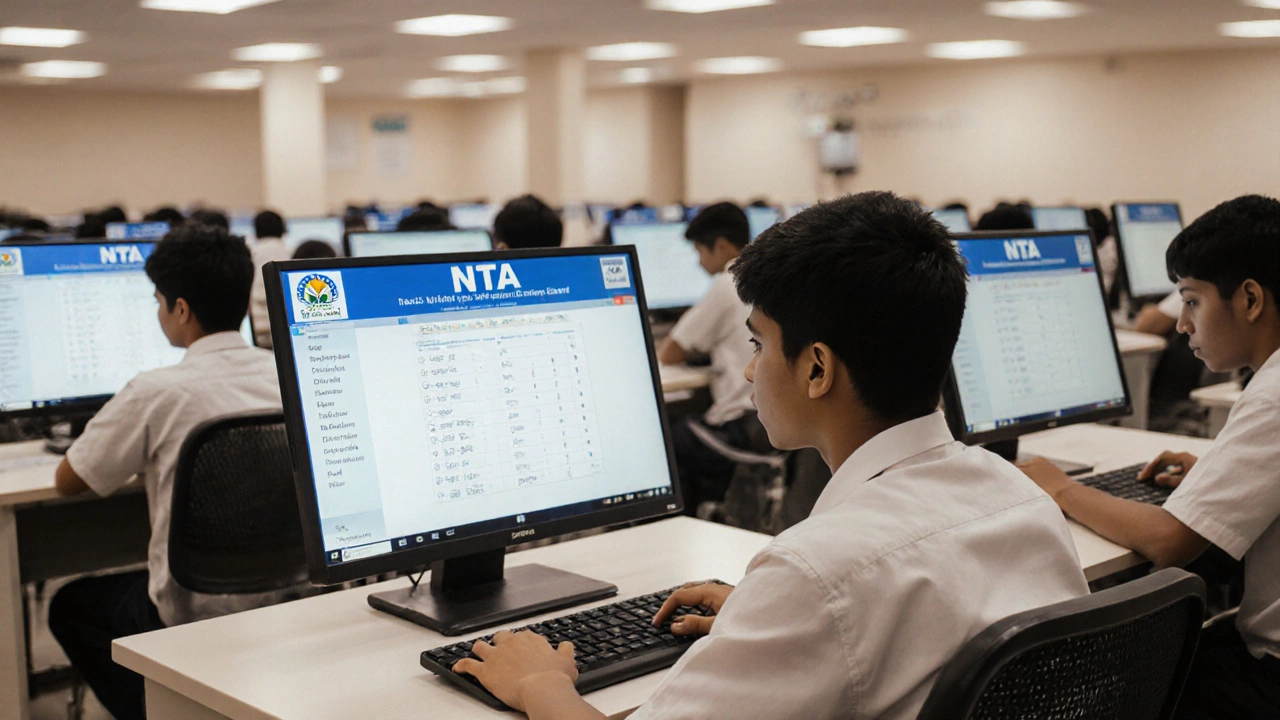JEE Advanced Eligibility Checker
Check Your JEE Advanced Eligibility
Enter your JEE Mains percentile to see if you qualify for JEE Advanced and what rank you might achieve.
Enter your percentile to see eligibility status
Key Takeaways
- JEE Mains is the gateway exam; JEE Advanced is the selection exam for IITs.
- Both are conducted by the National Testing Agency (NTA), but on different dates.
- Scoring systems differ: Mains uses percentile; Advanced uses raw marks.
- Eligibility for Advanced requires a qualifying Mains score and rank.
- Outcome paths diverge: Mains opens doors to NITs, IIITs, and other engineering colleges; Advanced leads to IIT admissions via Joint Seat Allocation Authority (JoSAA).
What is JEE Mains?
JEE Mains is a national-level engineering entrance test administered by the National Testing Agency (NTA). It evaluates candidates in Physics, Chemistry, and Mathematics (PCM) through a computer‑based test (CBT). The exam is offered twice a year - typically in January and April - and serves two main purposes: (1) ranking for admission to National Institutes of Technology (NITs), Indian Institutes of Information Technology (IIITs), and other centrally funded engineering colleges, and (2) a qualifying stage for the JEE Advanced exam.
The score is reported as a percentile, reflecting a candidate’s performance relative to all test‑takers. A higher percentile translates to a better chance of securing a seat in top engineering colleges.
What is JEE Advanced?
JEE Advanced is the second tier exam that determines admission to the Indian Institutes of Technology (IITs). Only candidates who clear the JEE Mains eligibility criteria (minimum percentile and rank) are allowed to sit for Advanced. The exam is conducted once a year, usually in May, and consists of two papers, each testing deeper understanding and problem‑solving skills in Physics, Chemistry, and Mathematics.
Scoring for Advanced is based on raw marks obtained across the two papers. The final rank is derived from the total marks, and JoSAA uses this rank to allocate IIT seats.
Core Differences at a Glance
| Aspect | JEE Mains | JEE Advanced |
|---|---|---|
| Conducting Body | NTA | NTA (on behalf of IITs) |
| Frequency | Twice a year | Once a year |
| Number of Papers | One (Paper‑1, Paper‑2 optional) | Two (Paper‑1 & Paper‑2) |
| Scoring Method | Percentile | Raw marks |
| Eligible Institutes | NITs, IIITs, GFTIs, private engineering colleges | IITs only |
| Cut‑off Basis | Percentile threshold (usually ~75‑80) | Rank requirement (depends on year) |
| Application Platform | NTA portal (JEE‑Main) | NTA portal (JEE‑Advanced) |

Eligibility and Registration Process
Both exams share a common eligibility framework, but each adds its own layer.
- Basic Academic Requirement: Candidates must have passed Class 12 (or equivalent) with Physics, Chemistry, and Mathematics.
- Age Limits: For JEE Mains, the candidate must be at least 17 years old on 1 June of the admission year. No upper age limit for Advanced, but the candidate must have appeared for Mains.
- JEE Mains Registration: Register on the NTA online portal, upload documents, pay the fee (≈ ₹ 650 for a single attempt), and select a test centre.
- Qualifying for JEE Advanced: After Mains results, JEE Advanced publishes a rank list. Only the top‑scoring candidates (typically around 2.5‑3 lakhs) who meet the percentile cut‑off can apply for Advanced.
- JEE Advanced Registration: Qualified candidates re‑register on the same NTA portal, but this time submit the Advanced‑specific application, pay the higher fee (≈ ₹ 1400), and choose a centre.
Scoring, Rank, and What They Mean
JEE Mains Score is expressed as a percentile ranging from 0 to 100. The percentile is calculated against the total number of candidates who appeared for the exam. A 90‑percentile means the candidate performed better than 90 % of test‑takers.
For JEE Advanced Rank, the raw marks from both papers are summed. The rank is then derived by ordering candidates from highest to lowest total marks. This rank directly feeds into the JoSAA counselling process.
Understanding these metrics helps aspirants set realistic target scores. For instance, a 150‑rank in Advanced usually secures a seat in an IIT with a good branch, while a 75‑percentile in Mains may be enough for a top NIT.
Path After Each Exam
If you clear only JEE Mains, you become eligible for admission to NITs, IIITs, and other government‑funded engineering colleges through the Central Seat Allocation Board (CSAB) and state counselling rounds. Your percentile determines the list of colleges you can select.
Clearing JEE Advanced opens the door to the prestigious IITs. Your rank is submitted to JoSAA, which conducts a single‑window counselling where you choose an IIT, a branch, and a campus based on seat availability and your preference.
Some students also use a good Mains score to apply for foreign universities that accept Indian entrance exams, but that’s a niche route.

Effective Preparation Strategies
- Start Early: Build a solid foundation in PCM during Class 11; practice conceptual problems before moving to speed drills.
- Mock Tests: Take at least one full‑length mock every two weeks for Mains, and weekly mocks for Advanced once you qualify.
- Analyze Errors: After each mock, spend as much time reviewing wrong answers as you did solving them.
- Targeted Revision: Use short notes for formulas, reaction mechanisms, and key theorems; revise them daily in the final month.
- Time Management: Practice with the official time limits - 180 minutes for Mains (90 minutes per paper) and 240 minutes for Advanced (120 minutes per paper).
Common Misconceptions
Misconception 1: "If you ace JEE Mains, you don’t need Advanced." Not true - only IITs accept Advanced scores, and many top engineering aspirants aim for both.
Misconception 2: "Advanced is just a harder Mains." The format, question style, and marking scheme differ significantly; Advanced tests analytical depth rather than speed alone.
Misconception 3: "You can retake JEE Advanced multiple times in a year." Advanced is held only once a year, so you must plan carefully and qualify via Mains first.
Frequently Asked Questions
What is the minimum JEE Mains percentile to qualify for JEE Advanced?
The cut‑off varies each year but generally lies between 75‑80 percentile for the General category. Reserved categories have slightly lower thresholds.
Can I appear for JEE Advanced without taking JEE Mains in the same year?
No. You must have a valid JEE Mains score from the same admission cycle to be eligible for Advanced.
How many attempts are allowed for JEE Mains?
Candidates can attempt JEE Mains a maximum of three times per calendar year.
Does a good JEE Mains rank guarantee an IIT seat?
No. Only the JEE Advanced rank dictates IIT admissions. A high Mains rank secures NIT/IIIT seats, not IITs.
What is the role of JoSAA in the admission process?
JoSAA (Joint Seat Allocation Authority) conducts a single‑window counselling that allocates IIT seats based on JEE Advanced ranks and candidates’ preferences.
Understanding the nuances between IIT JEE exams helps you plot a realistic roadmap, choose the right preparation strategy, and avoid costly surprises on exam day.
